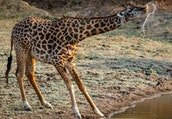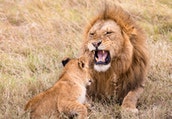- 1. Africa Warthog Appearance: Warthogs have a distinctive appearance, characterized by their four large warts on their face, which give them their name. These warts are actually thick pads of skin and provide protection during fights. They also have long, curved tusks that protrude from their mouths. The tusks are elongated canine teeth and are particularly long in males.
- 2. Africa Warthog Size: Warthogs are medium-sized animals, with males being slightly larger than females. They can stand about 2.5 to 3 feet (75 to 90 centimeters) tall at the shoulder and have a body length of about 3 to 5 feet (1 to 1.5 meters). They typically weigh between 110 to 330 pounds (50 to 150 kilograms).
- 3. Africa Warthog Reproduction: Female warthogs give birth to a litter of piglets after a gestation period of about 5 to 6 months. The piglets are precocial, meaning they are born relatively well-developed and can follow their mother shortly after birth.
- 4. Africa Warthog Habitat: Warthogs are adaptable animals and can be found in a variety of habitats, including grasslands, savannas, woodlands, and semi-deserts. They are distributed across sub-Saharan Africa, from countries like South Africa, Kenya, Tanzania, and Zimbabwe.
- 5. Africa Warthog Diet: Warthogs are omnivores and primarily feed on grass, roots, bulbs, and tubers. They use their snouts to dig into the ground to access underground food sources. In addition to vegetation, they will eat small invertebrates like insects and worms.
- 6. Africa Warthog Behavior: Warthogs are primarily diurnal, meaning they are active during the day. They are social animals and can often be seen in small family groups called sounders, which consist of a female and her offspring. Males are usually solitary or form bachelor groups.
- 7. Africa Warthog Predators: Warthogs have several natural predators, including lions, leopards, hyenas, and crocodiles. They are fast runners and can use their tusks to defend themselves against predators.
- 8. Africa Warthog Conservation Status: Warthogs are not considered endangered and have a stable population throughout their range.
Africa Warthog
The meerkat (Suricata suricatta) is a small mammal and a member of the mongoose family. Although not exclusive to Africa, meerkats are commonly associated with the continent and are often found in the southern and southwestern parts of Africa.
Africa Safari Tour Book online The cheetah safari
Here are some key points about the African Warthog:
Africa Warthog Safari Tour
An Africa Warthog safari tour provides a wonderful opportunity to observe these distinctive and charming creatures in their natural habitat. Although not the primary focus of most safaris, encounters with warthogs can be a delightful addition to your safari experience.
By planning ahead and choosing reputable safari operators or guides, While warthogs may not be considered one of the "Big Five," they add a special charm to the African safari experience. The diversity of wildlife encounters, coupled with the stunning landscapes, makes an Africa Warthog safari tour an unforgettable adventure. Embrace the magic of Africa's wildlife and immerse yourself in the beauty of the natural world during your safari journey.
Here are some key points to consider when planning an Africa Warthog safari tour:
Africa Warthogs Safari Destinations
Safari Destinations: Warthogs are widespread and can be found in various savannas, grasslands, and woodland habitats across sub-Saharan Africa. Some popular safari destinations where you may have a chance to see warthogs include:
- South Africa: Kruger National Park, Pilanesberg National Park, Madikwe Game Reserve, and others.
- Kenya: Maasai Mara National Reserve, Amboseli National Park, Tsavo National Parks, and more.
- Tanzania: Serengeti National Park, Ngorongoro Crater, Tarangire National Park, and other northern circuit parks.
- Botswana: Chobe National Park, Moremi Game Reserve, Okavango Delta, and others.
- Zimbabwe: Hwange National Park, Mana Pools National Park, and private conservancies.
Africa Warthog Behavior and Characteristics
Warthogs are diurnal animals, meaning they are active during the day. They can often be seen foraging on the ground for grass and other vegetation. Warthogs use their strong snouts to dig for roots and bulbs, sometimes kneeling down on their front knees to feed. Their distinctive warts and impressive tusks make them easily recognizable.
Africa Warthog Mixed Wildlife Encounters
Mixed Wildlife Encounters: While on your Warthog safari, you will likely encounter a variety of other African wildlife, including elephants, antelopes, zebras, giraffes, and numerous bird species.
Africa Warthog Responsible Wildlife Viewing
Responsible Wildlife Viewing: Always prioritize the well-being of the animals and follow the guidance of your safari guide to minimize any disturbance to the wildlife and their natural behaviors.
Africa Warthog Experienced Safari Guides
Experienced Safari Guides: Choose a safari operator that provides experienced guides who are knowledgeable about local wildlife and their habitats. Expert guides can enhance your safari experience with their insights into animal behavior and ecology.
Africa Warthog Photography Opportunities
Photography Opportunities: Bring a camera with a zoom lens to capture wildlife sightings, including the endearing and comical behaviors of warthogs.
Africa Warthog Conservation Awareness
Conservation Awareness: Learn about the importance of wildlife conservation and the role of warthogs in their ecosystems. Support responsible tourism practices that contribute to the protection of these wonderful creatures and their habitats.








 |
|  |
|  |
|  |
| 